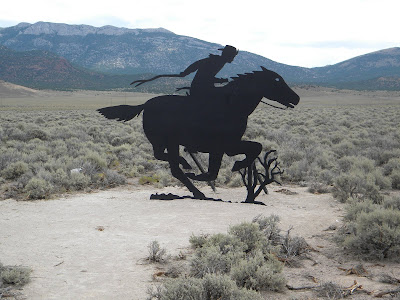
On Friday I took the Island Packers boat out to Santa Cruz Island to see the endemic scrub jay (above). This one sat around very obligingly as soon as we walked off the boat for our photo op. Then for the next 6 hours we rarely saw another jay altho we did hear them calling. Most of the people on the boat came out to camp or just spend the day hiking around. There were 2 other birders on the boat with me so we spent most of our time birding the area around the dock. Once we had seen most of the other birds on the island we just sat and talked until the boat returned to take us back to Ventura.
Santa Cruz Island is part of Channel Islands NP, and is considered to be our version of the Galapagos. The jay is the best known example since it has evolved enough over 10,000 years to be bigger and darker with a deeper "voice" than its scrub jay brethren on the mainland. It is only on Santa Cruz Island. I had been saving seeing this bird for my big year since most birders only make the trip out to the island once. On the way back in to Ventura harbor I also saw some pink-footed shearwaters, another new year bird.
Friday nite I stayed with a friend that I have known for almost 30 years. We went to eat at a local place called Sly's for an early celebration of her birthday. The place is known for its steak and seafood, so we had some of both. The mussels in cream broth were excellent as were the onion strings that we had as appetizers. My friend had some halibut cheeks, and I went with the aged Kansas City steak. These were accompanied by the local pinquitos (a small red bean) and some thin green beans with shallots. Our wine was probably the best thing we ordered--a '07 Melville pinot noir made from its Terraces vineyard grapes. Dessert was a meyer lemon tart that just had no real tartness, thus was flat and disappointing.
Yesterday the Condor Express left Santa Barbara harbor at 7 AM fully loaded with 78 birders, plus several spotters and its crew. I saw several birders that I have met over the years, including this year on other pelagic trips. I also was able to visit at length during the day with Bob Ake, a Virginia birder I met earlier in the year who is doing a full ABA big year. I had last seen him in Florida in April, so we compared notes on how our respective years were going so far. We discovered that other than Bob's friend John we had not met any one else so far doing a big year.
This is the 3rd time that I have gone out on the Condor, and yesterday was again an excellent day for sea birding. The weather was not great--overcast with at times early in the morning either mist or salt spray clouding my glasses and binocs. With the wind from the boat moving, it was also fairly chilly.
The early new birds for the year were black and ashy storm petrels, and red-necked phalaropes. Around 9 AM I and 3 other birders standing together on the bow saw a least storm petrel. As happens occasionally on a pelagic trip, none of the spotters or other birders picked up on this bird, but after comparing notes (very small, very dark, short tail, wing shape and its flight pattern), the 4 of us concurred that is what we saw.
We also saw lots of leach's storm petrels, sooty and pink-footed shearwaters, some terns and black-footed albatrosses, a few south polar skuas, all 3 jaegers (the long tailed was a new year bird), red phalaropes, and a single brown-headed cowbird. On the mammal front we saw sea lions, humpbacked, fin and baird's beaked whales, and lots of different kinds of dolphins.
The "miss" for the trip was cook's petrel. This is normally a very rare petrel on the west coast. But for some unknown reason it has been seen in large numbers over the past year, including in late June in the same area our boat was traversing. One was sighted mid-afternoon. I was in the cabin when it was called out, and by the time I made it outside, the bird had moved so far away from the boat that I could not pick it up. 2 more were seen off the back of the boat later in the afternoon, but again I was not able to see them.
The last day of July ended with the very long ride back to the harbor. We covered about 300 nautical miles for the day, and did not arrive back to Santa Barbara until about 9:30 PM. Another long and tiring day of seabirding, but very satisfying since after only 7 months of almost full time birding I have passed 650 birds seen for the year. For those who have been following my postings all year, you may remember that I said 650 birds would be a very good effort for the full year. So I have 5 more months to put major icing on my big year birding cake.
The other new year birds were sabine's gull, xantu's murrelet (both scrippsi and hypolueca), and buller's shearwater. Overall, 49 birds were seen on the 1st two days of week #31. 9 new birds bring the YTD number up to 656, and the least storm petrel along with the xantu's murrelet and the jay were life birds. I am off to LA today to find spotted dove and california gnatcatcher. Stay tuned!
































